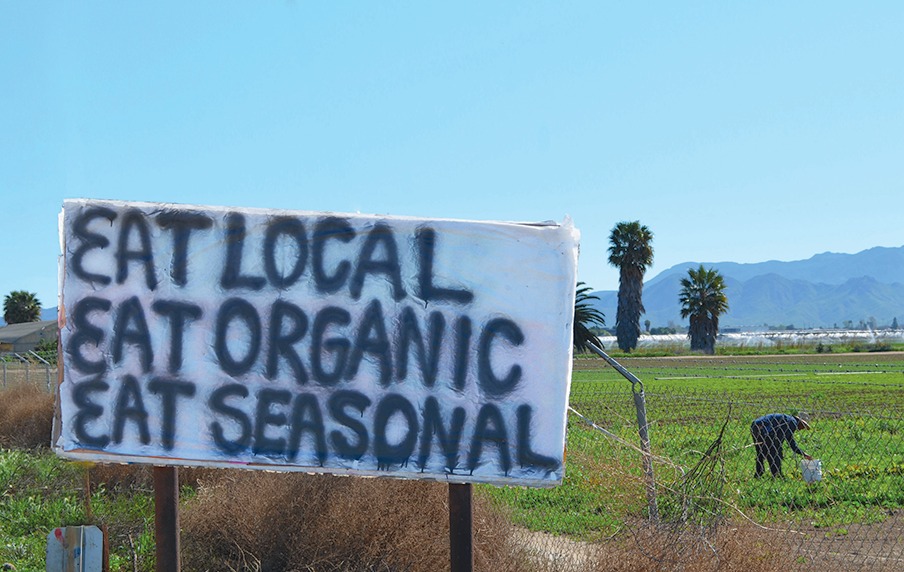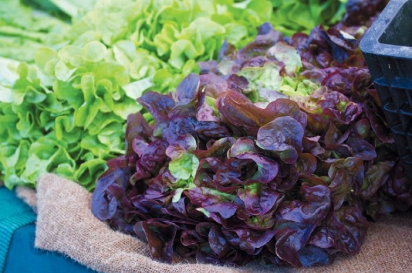Buy Local: Dare To Become A Freshness Addict
Customers at the farmers’ markets still think the produce should be cheaper than retail. They reason that two or three handlers have been removed from the equation and the price should be somewhere south of a small fortune. What’s not evident to the consumer is the unseen “cost of doing business” at these markets. Farmers must truck it (fuel), probably pay one or more vendors to work the tables and finally pay market management for the opportunity to sell. The percentages charged by market management are between 5 and 8%.
By comparison, a box of 24 bunches of certified organic chard in the field is worth between 80 cents and a dollar per bunch when sold into the mysterious maw of retail produce conveyance.
The price goes up after all the trucking and handling of distributors and consolidators, and finally retailers lay on their mark-up in the store. Now the chard costs $2.89. Every step of the way the chard had to be babied and refrigerated so that the Fresh was protected. If you don’t maintain your Fresh you suffer the Shrink. “Shrink” is the vague loss of value and marketability that causes unwanted chard to move along to charity, livestock or the dumpster.
Though consumers are probably unaware of the Shrink, this too is also a problem for farmers attending farmers’ markets. After the market is over, what happens to the produce you didn’t sell? Charity and hogs, chickens and compost. Freebies to the fawning seagulls, swooping down at closing time. We all end up paying for what gets lost. It’s not as bad as losing all the fresh capital value in your house when the sharpies decide to game the market, but losses in all aspects of market are borne by everyone.
The Fresh is the reason why retail-equivalent prices are acceptable at farmers’ markets. The taste of the Fresh and the incomparable health values of the just-picked create a felicitous addiction. Fresh is like a diamond compared to the commonplace of coal. No one should argue about 50 Fresh cents when the value of the limp alternative is a matter of convenience and desperation.
The only Fresh that’s better is in a local CSA box … or at some obscure retailer that has some pipeline to a farm. CSA Fresh can be four hours old, max. Customers chafe at the door as we ready our CSA boxes, unwilling to let an extra minute pass before they can sample that virgin parsley. Farmers’ market Fresh is usually 18 hours. There is no Fresh at retail, usually.
When a neophyte consumer lifts a bunch of 18-hour organic carrots off a farmer’s table, normally never-sensed odors waft upward, beguiling the nose as the intense color of Life seduces the eyes. The richness of natural earth is somehow present. A ladybug placed among the leaves by God flies off. Those who are attuned to vegetation can hear celery sing in the field, just like those who are aware listen for the Omming hum of a sacred fern-covered forest.
The song of Life still echoes on the farmer’s table, ever so subtly. You don’t really know why you stopped in front of that lettuce. Somehow it “spoke” to you, and when you reached for it, its leaves curled around your thumb as if to say, “Take me; I belong to you.”
You now are a Freshness addict.
It’s raining buckets, but you still load your bags into the trunk. Forget the coffee. Th ere are blueberries with bounce to be had. You stayed late and drank too much Tempranillo at the party but you know you can cure that fuzzy head with tender spinach whose white rootlets testify to their brief time out of the ground. You might be late for that golf game, but you’ll dare not disappoint your spouse by failing to haul home her beloved farmers’ market apples and celery, stiff as a four iron.
Fresh beats Limp hands down. Your mouth won’t lie, even when your wallet weeps, so seek out the Freshest and it may end up being worth five times the money in health prevention. Eve gave Adam a fresh apple to sample. Just imagine what would have happened if she’d given him one from a Big Box and he had refused it. We never would have had Original Sin.
WHY BUY LOCAL
“South” is also where a lot of our fresh produce comes from these days, where people are paid $7 a day, not $90 or more, which is the daily wage of U.S. farm labor.
It takes awhile to fill up a box of cherry tomatoes or pick a pound of snow peas or green beans, which is why the smart money invested in transnational consumerism. So strike a blow against the inequities of “Free Trade” and join a CSA or shop at a farmers’ market or farmer-owned business.
The job you save may be your own! Flag waving can be so tiresome, but remember that you are paying for American Food Security and Sovereignty when purchasing domestically produced products. An American green bean is a better green bean because it’s our green bean, fresh and alive with patriotic flavor.






